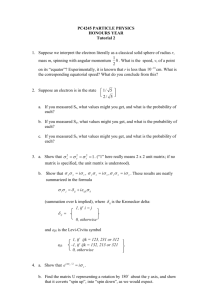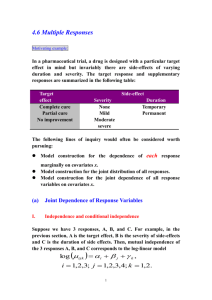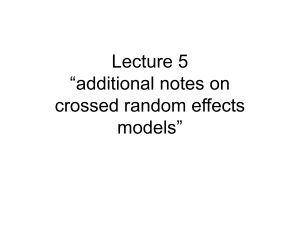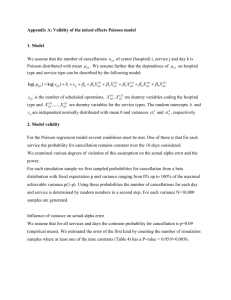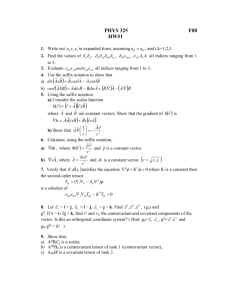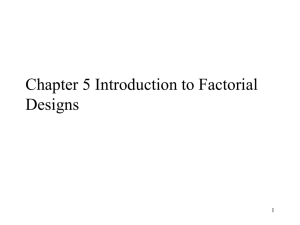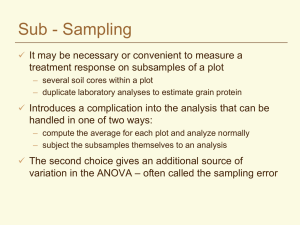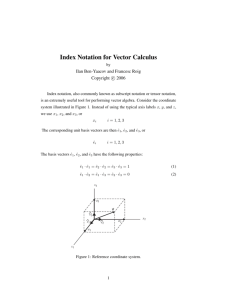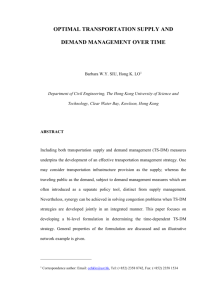Lecture 5: More About Suffix Notation 5. 1. Einstein Summation
advertisement
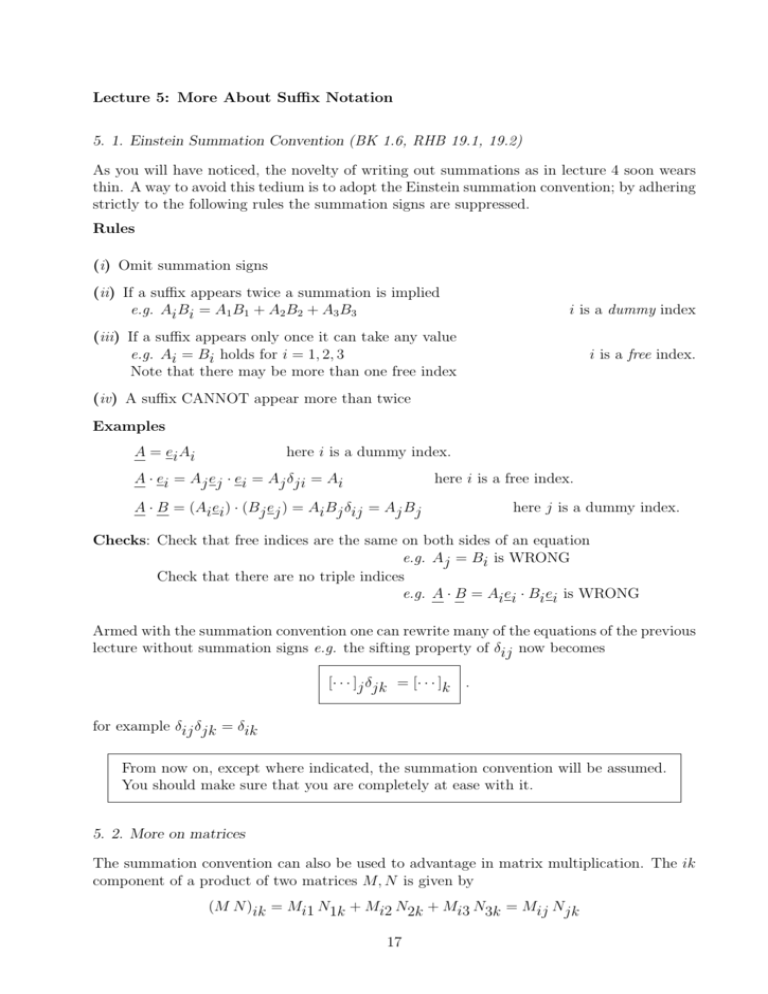
Lecture 5: More About Suffix Notation
5. 1. Einstein Summation Convention (BK 1.6, RHB 19.1, 19.2)
As you will have noticed, the novelty of writing out summations as in lecture 4 soon wears
thin. A way to avoid this tedium is to adopt the Einstein summation convention; by adhering
strictly to the following rules the summation signs are suppressed.
Rules
(i) Omit summation signs
(ii) If a suffix appears twice a summation is implied
e.g. Ai Bi = A1 B1 + A2 B2 + A3 B3
i is a dummy index
(iii) If a suffix appears only once it can take any value
e.g. Ai = Bi holds for i = 1, 2, 3
Note that there may be more than one free index
i is a free index.
(iv) A suffix CANNOT appear more than twice
Examples
A = ei Ai
here i is a dummy index.
A · ei = Aj ej · ei = Aj δji = Ai
here i is a free index.
A · B = (Ai ei ) · (Bj ej ) = Ai Bj δij = Aj Bj
here j is a dummy index.
Checks: Check that free indices are the same on both sides of an equation
e.g. Aj = Bi is WRONG
Check that there are no triple indices
e.g. A · B = Ai ei · Bi ei is WRONG
Armed with the summation convention one can rewrite many of the equations of the previous
lecture without summation signs e.g. the sifting property of δij now becomes
[· · · ]j δjk = [· · · ]k
.
for example δij δjk = δik
From now on, except where indicated, the summation convention will be assumed.
You should make sure that you are completely at ease with it.
5. 2. More on matrices
The summation convention can also be used to advantage in matrix multiplication. The ik
component of a product of two matrices M, N is given by
(M N )ik = Mi1 N1k + Mi2 N2k + Mi3 N3k = Mij Njk
17
T
Likewise, recalling the definition of the transpose of a matrix Mij
= Mji
T
(M T N )ik = Mij
Njk = Mji Njk
We saw in the previous lecture that δij is represented by the identity matrix. Thus the
sifting property
Mij δjk = Mik
is simply interpreted as multiplication of a matrix M by the identity matrix.
The determinant of a matrix M , is denoted by |M | or det M . We state in passing some
properties of determinants of matrices which you should already know e.g.
|M N | = |M ||N | = |N M |
|M T | = |M |
5. 3. Levi-Civita Symbol ijk (RHB 19.8)
We saw in the last lecture how δij could be used to greatly simplify the writing out of the
orthonormality condition on basis vectors.
We seek to make a similar simplification for the vector products of basis vectors (taken here
to be right handed) i.e. we seek a simple, uniform way of writing the equations
e1 × e2 = e3 e2 × e3 = e1 e3 × e1 = e2
e1 × e1 = 0 e2 × e2 = 0 e3 × e3 = 0
To do so we define the Levi-Cevita symbol ijk (pronounced ‘epsilon i j k’), where i, j and
k can take on the values 1 to 3, such that:–
ijk = +1 if (i, j, k) is an even permutation of (123) ;
= −1 if (i, j, k) is an odd permutation of (123) ;
= 0 otherwise (i.e. 2 or more indices are the same) .
For example,
123
213
312
113
=
=
=
=
+1 ;
−1 { since (123) → (213) under one permutation [1 ↔ 2]} ;
+1 {(123) → (132) → (312); 2 permutations; [2 ↔ 3][1 ↔ 3]} ;
0 ; 111 = 0 ; etc.
123 = 231 = 312 = +1 ; 213 = 321 = 132 = −1 ; all others = 0 .
5. 4. Vector product
The equations satisfied by the vector products of the (right-handed) orthonormal basis vectors ei can now be written uniformly as :–
18
ei × ej = ijk ek
(i, j = 1,2,3) .
e.g.
e1 × e2 = 121 e1 + 122 e2 + 123 e3 = e3
;
e1 × e1 = 111 e1 + 112 e2 + 113 e3 = 0
Also,
A × B = Ai Bj ei × ej
= ijk Ai Bj ek
but,
A × B = (A × B)k ek .
Thus
(A × B)k = ijk Ai Bj
Always recall that we are using the summation convention. For example writing out the
sums
(A × B)3
= 113 A1 B1 + 123 A2 B3 + 133 A3 B3 + · · ·
= 123 A1 B2 + 213 A2 B1
(only non-zero terms)
= A1 B2 − A2 B1
Now note a ‘cyclic symmetry’ of ijk
ijk = kij = jki = −jik = −ikj = −kji
This holds for any choice of i, j and k. To understand this note that
1. If any pair of the free indices i, j, k are the same, all terms vanish;
2. If (ijk) is an even (odd) permutation of (123), then so is (jki) and (kij), but (jik),
(ikj) and (kji) are odd (even) permutations of (123).
Now use the cylic symmetry to find alternative forms for the components of the vector
product
(A × B)k =
ijk Ai Bj = kij Ai Bj
or relabelling indices
k→i i→j j→k
(A × B)i = jki Aj Bk = ijk Aj Bk .
The scalar triple product can also be written using ijk
(A, B, C) = A · (B × C) = Ai (B × C)i
19
(A, B, C) = ijk Ai Bj Ck .
Now as an exercise in index manipulation we can prove the cylic symmetry of the scalar
product (A, B, C) = ijk Ai Bj Ck
= −ikj Ai Bj Ck
interchanging two indices of ikj
= +kij Ai Bj Ck
= ijk Aj Bk Ci
interchanging two indices again
relabelling indices k → i i → j
j→k
= ijk Ci Aj Bk = (C, A, B)
5. 5. Product of two Levi-Civita symbols
We state without formal proof the following identity (see tutorial questions 3.7 3.8)
ijk rsk = δir δjs − δis δjr .
To verify this is true one can check all possible cases e.g. 12k 12k = 121 121 + 122 122 +
123 123 = 1 = δ11 δ22 − δ12 δ21 . More generally, note that the left hand side of the boxed
equation may be written out as
• ij1 rs1 + ij2 rs2 + ij3 rs3 where i, j, r, s are free indices.
• For this to be non-zero we must have i 6= j and r 6= s
• Only one term of the three in the sum can be non-zero
• If i = r and j = s we have +1
; If i = s and j = r we have −1
The product identity furnishes an algebraic proof for the ‘BAC-CAB’ rule. Consider the ith
component of A × (B × C):
A × (B × C) i = ijk Aj (B × C)k
= ijk Aj klm Bl Cm = ijk lmk Aj Bl Cm
= (δil δjm − δim δjl ) Aj Bl Cm
= (Aj Bi Cj − Aj Bj Ci )
= (A · C)Bi − (A · B)Ci
= (A · C)B − (A · B)C i
Since i is a free index we have proven the identity for all three components i = 1, 2, 3.
20
